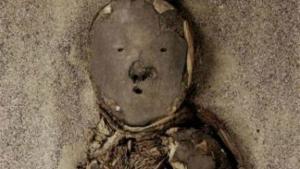Mummy is always one of the interesting topics. But unlike movies, the facts about mummies can make you big surprise.
The ancient Egyptians believed that, when a king died, that king’s body needed to be preserved intact so that their soul could reach the afterlife. The king of eternity would become a god and be worshiped by the people along the banks of the Nile. To be able to do this, the art of mummification was created to ensure that the bodies of the Pharaohs did not decompose over time and they were also placed in pyramids that have survived to this day.
On the other hand, commoners were only buried in the desert sands.

The oldest Chinchorro mummy found is 7,000 years old.
2000 years before the Egyptians invented the method of mummification, the Chinchorro people living in what is now Chile and Peru impregnated the bodies of the deceased. The oldest Chinchorro mummy found dates back 7,000 years.
The body of the deceased was removed internal organs, the skin was sewn closed, painted black from head to toe. The Chinchorro also made a wig for mummies, keeping their eyes and mouth open. There is no official information about the customs of the Chinchorro people, but there are theories that this is how they take advantage of the natural climate to avoid diseases caused by decaying corpses.

Many pharaohs were buried with the cat they raised during their lifetime.
When a Pharaoh dies, the king’s body isn’t the only thing that gets embalmed. Some animals, especially cats, were also mummified and buried with the Pharaohs. In Egyptian culture, cats were considered a sacred animal, a messenger of good luck.
In addition, cats can also kill insects or even desert snakes, so they are even more loved by the Egyptians. Many kings were buried with the cat they raised during their lifetime.

Mummies in ancient Europe were often sold for skin or ground into a powder and then mixed with drinking water to prevent illness.
In the 16th century, many Europeans including priests, royalty and scientists used human body parts such as bones, blood, and even fat as a panacea for everything from headaches to headaches. epileptic. Mummies are often sold for skin or ground into a powder and mixed with drinking water to treat bruises and other ailments. The skulls of mummies are the most valuable, they are often crushed to make a headache medicine.
Some other discoveries of this era were the use of fat from the mummy to rub on the wound, which they said could stop bleeding and reduce pain. In addition, mummy powder is said to stop nosebleeds. Anyway, these remedies are really monstrous.
Considered the greatest Pharaoh in history, Ramesses II ruled Egypt for six decades from 1279-1213 BC. His mummy was originally buried in pyramid KV7 in the valley of the kings, but due to rampant tomb theft, his burial place was constantly changed.
In 1974, archaeologists found the mummy of Ramesses II, found it in a state of disrepair, and decided to bring it back to Paris for preservation. Before boarding the plane to France, the mummy was issued a passport with Egyptian citizenship, occupation as King (deceased). The study of the mummy of Ramesses II also shows that the ancient Egyptian method of mummification was immune to mold, in addition, the king also showed signs of battle wounds and rheumatic diseases. joints of old age.

